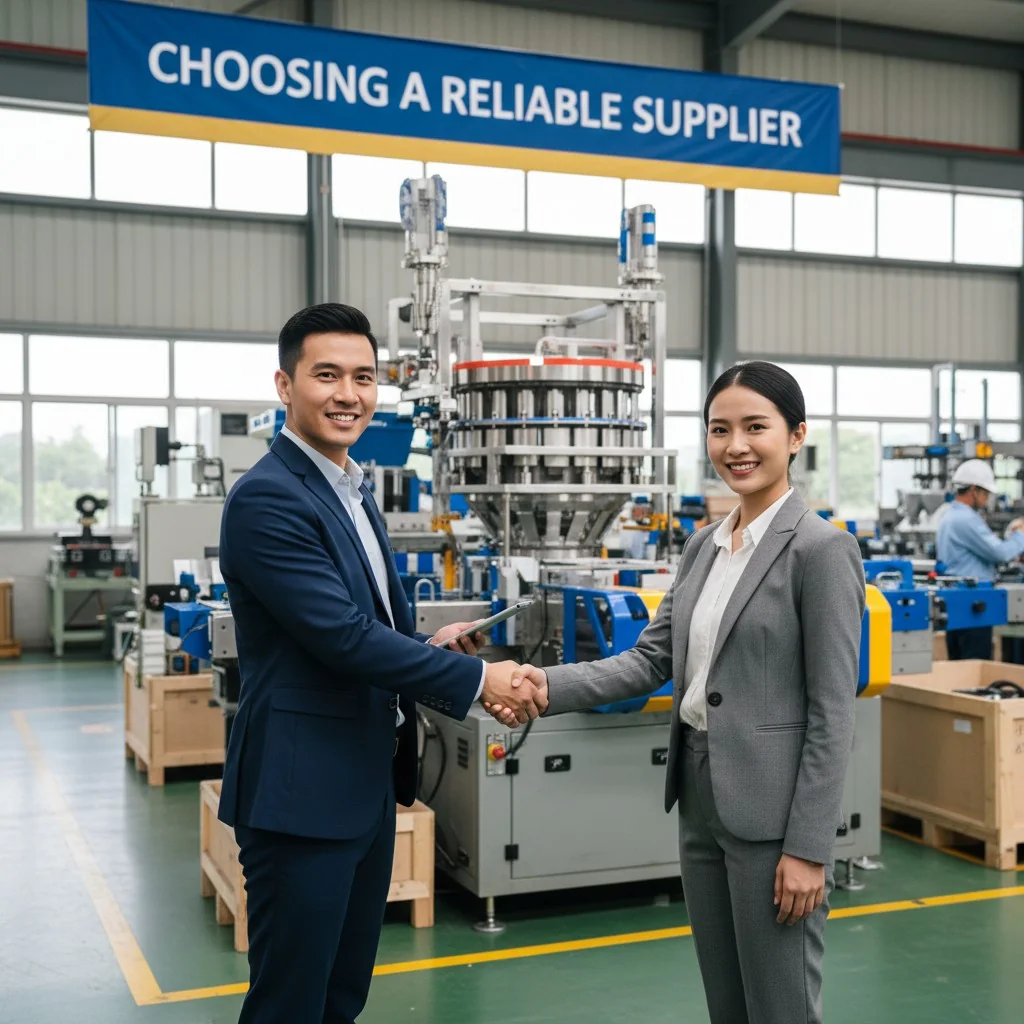
Your fresh products are spoiling too fast, causing waste and lost revenue. This hurts your brand's reputation and makes it hard to grow. Modified Atmosphere Packaging[^1] extends shelf life significantly.
A Modified Atmosphere Packaging (MAP) machine is a system that alters the gaseous environment inside a food package before sealing it. It replaces ambient air with a specific gas mixture, typically nitrogen and carbon dioxide, to slow spoilage, preserve freshness, and extend the product's shelf life[^2].

I've been in the manufacturing world for a long time, starting on the factory floor. I've seen how small changes in process can have a huge impact on the final product. When I first encountered MAP technology, I was amazed. It wasn't just about wrapping a product; it was about creating a perfect environment to preserve its quality. It showed me that the package is just as important as the product inside. This technology is a game-changer for anyone dealing with fresh goods, and understanding it is key. Let's look closer at how it works and what it can do for you.
MAP technology can extend the shelf life of fresh poultry from 4-7 days to 16-21 days.True
By reducing oxygen and inhibiting aerobic bacteria growth, MAP significantly slows down the spoilage process for products like chicken and turkey.
Modified Atmosphere Packaging completely sterilizes the food product.False
MAP does not sterilize food. It is a non-thermal preservation method that slows the growth of microorganisms and spoilage reactions, but it does not eliminate them entirely. Proper food hygiene is still essential.
How Does an Automatic Fresh Food Packaging Machine Work?
Manually packaging fresh food is slow, inconsistent, and costly. This variability can damage your product quality and frustrate your customers, hurting your bottom line and brand image.
An automatic fresh food packaging machine places a product into a tray or container. It then creates a vacuum to remove the air and flushes the package with a specific gas mixture[^3]. Finally, it hermetically seals the package with a top film to protect the product inside.

When you dive deeper, you see the precision involved. It's a multi-step process that has to be perfect every time to be effective. As a designer like Jacky, you'll appreciate the engineering behind it. The machine isn't just a sealer; it's a complete environmental control system for each package. The process starts with placing the food into a pre-formed tray, which you might have even designed the mold for. Then, the magic happens. The machine moves the tray into a chamber, removes the oxygen, and replaces it with a carefully controlled mix of gases. The final seal is critical. It has to be airtight to keep the special atmosphere in and contaminants out. This is where the design of the tray's sealing flange becomes so important. A poorly designed flange can lead to a bad seal, and the whole process is wasted.
The Key Stages of MAP
- Infeed: The product, placed in a tray, is fed into the machine.
- Vacuum: The chamber is sealed, and a vacuum pump removes the ambient air. This step removes the oxygen that fuels spoilage.
- Gas Flush: The machine injects a specific mixture of gases into the package.
- Sealing: A heated sealing head bonds a top film to the tray, creating an airtight seal.
- Discharge: The finished package is released from the machine.
Common Gas Mixtures
The gas mixture isn't random. It's tailored to the specific food product.
| Food Product | Typical Gas Mixture (CO₂ / N₂ / O₂) | Purpose |
|---|---|---|
| Red Meat | 20-30% CO₂ / 70-80% O₂ | High oxygen keeps the meat's red color. CO₂ inhibits bacteria. |
| Poultry | 30% CO₂ / 70% N₂ | Prevents bacterial growth without affecting color. |
| Fish | 40% CO₂ / 60% N₂ | High CO₂ is needed to strongly inhibit common fish spoilage bacteria. |
| Baked Goods | 50% CO₂ / 50% N₂ | Prevents mold growth and staling. |
| Fresh Pasta | 30% CO₂ / 70% N₂ | Inhibits mold and bacterial growth to extend freshness. |
The most common gases used in MAP are oxygen, carbon dioxide, and nitrogen.True
These three gases are chosen for their specific properties: CO₂ inhibits microbial growth, N₂ is an inert filler gas, and O₂ is used to maintain the red color of meat and for the respiration of fresh produce.
Any type of plastic film can be used for MAP.False
MAP requires specific barrier films with low gas permeability. The film must be able to maintain the modified atmosphere inside the package and prevent outside air from getting in. Materials like EVOH and PVDC are often used as barrier layers.
What are the Benefits for Your Business and Product Design?
You are always looking for an edge to improve product quality and reduce costs. But the competition is tough, and small inefficiencies add up, eating into your profits.
The main benefits are a much longer shelf life, less food waste[^4], and better-looking products. This leads to lower operational costs, the ability to sell in wider markets, and happier customers. For designers, it creates new challenges and opportunities for innovative packaging.

When I was helping clients grow their businesses, we often focused on the product itself. But I learned that packaging can be just as powerful. Investing in a technology like MAP has a ripple effect across the entire business. It's not just about keeping food fresh for a few more days. It's about transforming your logistics, reducing your environmental footprint, and strengthening your brand. For a designer, this is exciting. You are no longer just designing a container. You are designing a key part of the product preservation system. The material choices, the structural integrity of the tray, and the ergonomics of the package all become critical design elements that directly impact the bottom line.
Business Advantages
- Extended Shelf Life: This is the biggest win. It means less waste from spoilage.
- Wider Distribution: Longer shelf life allows you to ship products farther, opening up new markets.
- Reduced Need for Preservatives: The gas mixture naturally preserves the food, allowing for a cleaner ingredient list.
- Improved Presentation: The product looks better for longer, without being crushed by vacuum packaging. This improves customer perception.
- Increased Profitability: Less waste and more sales opportunities directly translate to a healthier bottom line.
Implications for Mold and Product Designers
As a designer, your role becomes even more crucial with MAP. The package must perform under pressure—literally.
| Design Consideration | Standard Tray | MAP Tray |
|---|---|---|
| Material | Basic polymers (e.g., PS, PET) | Multi-layer barrier polymers (e.g., PP/EVOH/PP) |
| Seal Flange | Simple, for basic lid fit | Wide, flat, and rigid for a perfect hermetic seal |
| Structural Rigidity | Moderate | ከፍተኛ, to withstand vacuum and gas pressure |
| Stacking Features | Optional | Essential, for transport and retail display |
| Aesthetics | Secondary concern | Key for brand appeal and showing product quality |
MAP packaging is always more expensive than traditional packaging.False
While the initial investment in machinery and barrier films can be higher, the total cost of ownership is often lower. This is due to significant savings from reduced food waste, fewer product returns, and expanded distribution capabilities.
In Europe, a significant portion of retail fresh meat is packaged using MAP.True
Studies and market reports confirm that MAP is the dominant packaging technology for fresh meat in the European retail sector, valued for its ability to extend shelf life while maintaining the meat's desirable red color.
How Do You Choose a Reliable MAP Machine Supplier?
Choosing a major piece of equipment like a MAP machine is a huge decision. Making the wrong choice can lead to constant production headaches, costly downtime, and a wasted investment.
To find a reliable partner, look for a supplier with a long history, proven machine reliability, and great customer support. Always check their certifications, ask for client case studies, and make sure they understand your specific product and packaging needs.

This part of the process is personal for me. When I started my trading company, I spent a lot of time sourcing machinery and building relationships with suppliers. I learned that the price tag is only one small part of the story. A cheap machine from an unreliable supplier can cost you a fortune in the long run. I focused on finding partners, not just sellers. This is especially true when sourcing from a place like China. There are many misconceptions, but the industry there has matured incredibly. Since I started working with suppliers there in 2004, I've seen them develop world-class technology. The key is to do your homework and find the right ones.
Key Supplier Evaluation Criteria
You need a checklist to guide your decision. Don't get distracted by a slick sales pitch. Focus on the facts.
- Experience: How long have they been in business? Look for suppliers with over a decade of experience, like the ones I started working with back in 2004.
- Certifications: Do they have internationally recognized certifications like CE for Europe or ISO 9001 for quality management? This is a non-negotiable sign of quality.
- Technical Support: What happens when something goes wrong? Ensure they have accessible, expert support and can provide spare parts quickly.
- Customization: Can they adapt the machine to your specific trays, films, and products? A one-size-fits-all solution rarely works.
- Case Studies: Ask for real-world examples and references. A confident supplier will be happy to share their success stories.
My Experience with Sourcing from China
Many people are hesitant about sourcing major equipment from China. I understand why. But my experience has been very positive, as long as you are careful. The best Chinese suppliers today offer incredible value. Their technology is robust, their prices are competitive, and their willingness to work with you is high. The key is to look past old stereotypes. Judge them on their engineering, their track record, and the quality of their support. A reliable Chinese partner can be a huge asset for your business growth, just as they were for mine.
CE marking is a mandatory conformity mark for machines sold within the European Economic Area.True
The CE mark indicates that the manufacturer has checked that the product meets EU safety, health, and environmental requirements. It is a key indicator of a machine's compliance with high safety standards.
The lowest-priced machine always offers the best value.False
The true cost of a machine is its Total Cost of Ownership (TCO), which includes the purchase price plus maintenance, downtime, spare parts, and energy consumption. A cheaper machine can have a much higher TCO.
ማጠቃለያ
MAP machines extend shelf life, reduce waste, and improve product quality. Choosing the right machine and a reliable supplier is the key to unlocking these powerful benefits for your business.
References
[^1]: Explore how MAP can significantly extend shelf life and reduce food waste, enhancing your product's marketability.
[^2]: Understanding the impact of packaging on shelf life can help you make informed decisions for your products.
[^3]: Learn about the specific gas mixtures used in MAP and their effects on food preservation.
[^4]: Discover strategies to minimize food waste through innovative packaging solutions.
